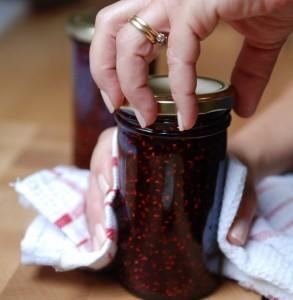No more real jam tomorrow
Vivien Lloyd of Vivien Lloyd Preserves reflects on the looming demise of traditional jam in this guest blog post.
The Jam and Similar Products (England) Regulations 2013
After months of debate, the waiting is over. Following a consultation, Defra have decided to reduce the permitted sugar level for jams, jellies and marmalades from 60% to 50%, remove the UK national limit for ‘reduced sugar jam’ and remove the national provisions for curds and mincemeat.
Reducing permitted sugar levels from 60% to 50% will, over time, destroy the characteristic quality of British jams, jellies and marmalades and could potentially mislead consumers. Traditional jams are a mixture of cooked fruit without additives. The quality of these preserves is determined by the proportions of sugar, fruit, pectin and acid in the product. By reducing the percentages of total sugar content, the characteristic gel in the consistency of jams, jellies and marmalades will be lost. The result will be either a homogenized, spreadable substance or a gloopy product bearing no resemblance to the products we enjoy as jams, jellies and marmalades.
British scientists who worked at Long Ashton Agricultural Research Station at Bristol University during the 1920’s examined the shelf-life of jams and similar products. A recommendation was made for a minimum sugar content of 60% regardless of the type of fruit used in the recipe. This ensured a good shelf-life of at least a year. The 60% has its origins not in Brussels but in Bristol.
These new regulations revise the Jam and Similar Products Regulations 2003. These state that the percentage of soluble solids content for jams, jellies and marmalades must be 60%, unless the product is one with reduced sugar, with a permitted percentage of between 25% and 50%.
This will encourage more reduced sugar products to be made, as they might be perceived as more healthy. Some jam manufacturers have urged caution. In the Impact Assessment document for the new regulations it was cited as potentially increasing the risk of spoilage. Currently, reduced sugar products with a percentage of 25% to 50% often contain chemical additives to ensure a good shelf-life, for example Potassium sorbate, E202.
At a time when public attention is being directed to the content of food, it seems inadvisable to encourage the unnecessary production of products with additives and artificial flavours. The 50% permitted sugar level will be lower than the 55% minimum adopted by France and Germany. The jams produced by these countries have always been different to ours. Historically, their jams and similar products are made using different methods which do not produce the British characteristic gel in the consistency. They are referred to as soft set products, with a loose, almost pouring consistency.
Within the industry, there is no appetite for a reduction from some of the high quality manufacturers in England, Scotland and Wales; notably, Tiptree, Mackays, and Wendy Brandon Preserves.
How will the National Federation of Women’s Institutes respond to these regulations? Historically, they are the best known organisation to instruct their members and the wider public about the characteristics of sweet preserves. Their publication ‘On with the Show” lists the criteria for judging these preserves. Out of the 132 organisations consulted by Defra, the National Federation of Women’s Institutes was one of a handful who claimed to have received a consultation letter. Surprisingly, they did not respond to it, but they will be left with their rules to consider. How will these new products be judged in competitions?
Deregulating the provisions for curds and mincemeats, as listed in Jam and Similar Products Regulations 2003, will stimulate the creation of other products labelled as curds or mincemeat. In 2003 Defra asked the industry if they wanted to retain the national rules for curds and mincemeat and the overwhelming response was positive. At the time industry felt there was a need to set minimum rules to ensure the quality of these products and prevent poor quality or inferior substitutes.
Mincemeat has a history traceable back to the late seventeenth century following Cromwell’s two year ban on Christmas festivities. After his death and once Christmas had been reinstated as a festival, the mincemeat we know today was introduced – a product with a quantity of vine fruits, sugar, citrus peel, suet or equivalent fat and optional alcohol. Fruit Curds, particularly Lemon Curd became well known in England during the late 1800’s. Recipes with eggs, butter, sugar and fruit were called “transparent puddings”. The method for storing them in jars became popular during the nineteenth century.
Fruit Curds are an emulsion of edible fat, sugar, egg and fruit. The 2003 regulations specified percentages of ingredients for the quantity of fat and eggs for every 1000 grams of the finished product. The quantity of fruit was sufficient to characterise the finished product. For mincemeat, the 2003 regulations specified the quantity of vine fruits, suet and citrus peel used for every 1000 grams. Curds and mincemeat had a soluble dry matter of 65% unless they were reduced sugar products. Any product lower than 65% was labelled “low sugar substitute”. Deregulation will no doubt stimulate the introduction of products very different from current curds and mincemeat.
The minority of producers manufacturing low sugar products have a natural desire to use the words consumers recognise Jam, Marmalade, Jelly, Mincemeat, Lemon Curd etc. I am left wondering how Defra will be confident consumers will not be misled when lower sugar fruit preserves are labelled as Jam or similar preserve, despite being materially different .The 2003 regulations were based on scientific research. I would be interested to read any government research to support the new regulations.
This post originally appeared on Vivien Lloyd Preserves blog and is reproduced here with permission.
Vivien Lloyd has over 25 years’ experience of making and demonstrating award-winning preserves and 18 years of judging preserves at competitions. Passionate about ensuring age-old traditional recipes are not passed over in favour of more modern interpretations, Vivien is keen to share her expertise and knowledge and to revive what she feels is a declining and misunderstood skill.
As a professional preserver, Vivien has been featured in Somerset Life, The Sunday Telegraph, on BBC 1’s The One Show and Radio 4’s The Food Programme. She has won numerous first prizes for her preserves and in 2008 won ‘Best of the Best’ for her Seville orange marmalade at the World’s Original Marmalade Festival. The recipe is featured in her books and DVD ‘Marvellous Marmalade’. Full details can be found on Vivien Lloyd Preserves.
Follow Vivien on Twitter @VivienLloyd or contact by e-mail: viv@vivienlloydpreserves.com
© 2013 Vivien Lloyd





